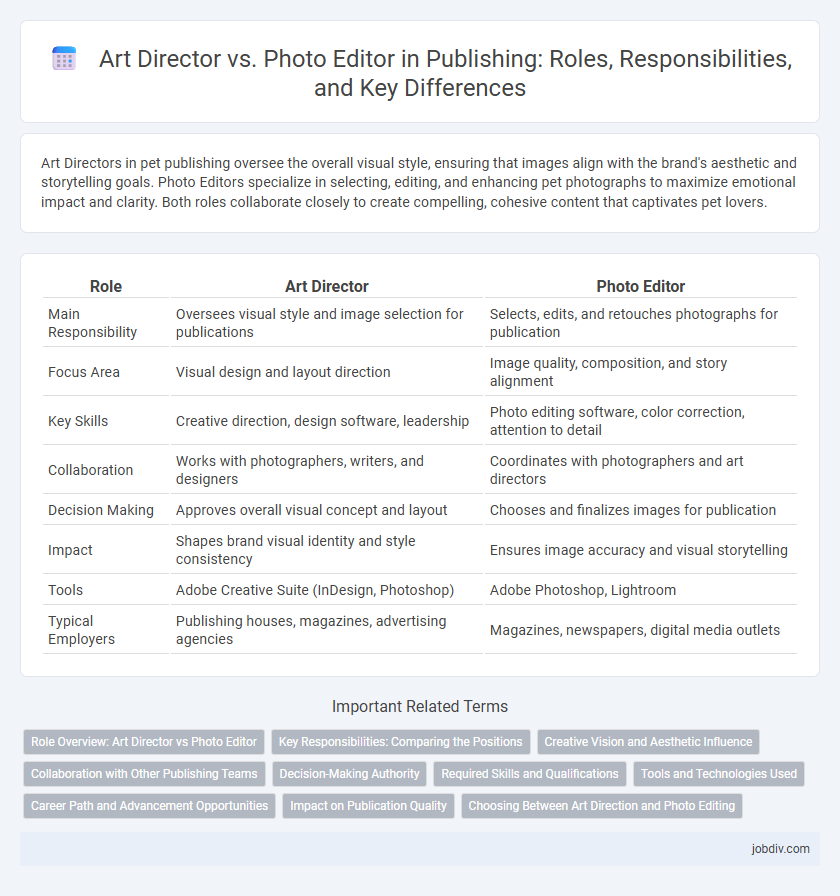Art Directors in pet publishing oversee the overall visual style, ensuring that images align with the brand's aesthetic and storytelling goals. Photo Editors specialize in selecting, editing, and enhancing pet photographs to maximize emotional impact and clarity. Both roles collaborate closely to create compelling, cohesive content that captivates pet lovers.
Table of Comparison
| Role | Art Director | Photo Editor |
|---|---|---|
| Main Responsibility | Oversees visual style and image selection for publications | Selects, edits, and retouches photographs for publication |
| Focus Area | Visual design and layout direction | Image quality, composition, and story alignment |
| Key Skills | Creative direction, design software, leadership | Photo editing software, color correction, attention to detail |
| Collaboration | Works with photographers, writers, and designers | Coordinates with photographers and art directors |
| Decision Making | Approves overall visual concept and layout | Chooses and finalizes images for publication |
| Impact | Shapes brand visual identity and style consistency | Ensures image accuracy and visual storytelling |
| Tools | Adobe Creative Suite (InDesign, Photoshop) | Adobe Photoshop, Lightroom |
| Typical Employers | Publishing houses, magazines, advertising agencies | Magazines, newspapers, digital media outlets |
Role Overview: Art Director vs Photo Editor
Art Directors oversee visual concepts and design direction, ensuring cohesive aesthetics across publishing projects by coordinating with designers, photographers, and other creatives. Photo Editors specialize in selecting, editing, and managing photographic content, focusing on image quality, relevance, and alignment with editorial goals. Both roles collaborate closely but maintain distinct responsibilities in shaping the visual narrative within publishing.
Key Responsibilities: Comparing the Positions
Art Directors oversee the visual style and creative direction of publishing projects, coordinating with designers, photographers, and illustrators to ensure cohesive aesthetics. Photo Editors specialize in selecting, editing, and managing photographic content, maintaining image quality and consistency throughout publications. Both roles collaborate closely to align visual elements with editorial goals, but Art Directors focus on broader conceptual design while Photo Editors handle technical photo curation and stewardship.
Creative Vision and Aesthetic Influence
Art Directors shape the overall creative vision by directing visual storytelling and establishing the aesthetic tone for publishing projects, ensuring cohesive brand identity across platforms. Photo Editors specialize in selecting and refining images, enhancing visual appeal while aligning photographs with the intended narrative and style guidelines. Both roles collaboratively influence the publication's aesthetic but differ in scope, with Art Directors focusing on holistic design and Photo Editors concentrating on imagery perfection.
Collaboration with Other Publishing Teams
An Art Director collaborates closely with graphic designers, copywriters, and marketing teams to develop cohesive visual content that aligns with the publication's brand identity. Photo Editors work with photographers, photo agencies, and editors to select and enhance images that complement editorial narratives. Both roles coordinate to ensure that visual storytelling supports the overall publication strategy and enhances reader engagement.
Decision-Making Authority
Art Directors hold primary decision-making authority over visual concepts and overall design direction in publishing projects, shaping the creative vision and final aesthetic. Photo Editors focus on selecting, sourcing, and managing photographic content, making critical decisions about image quality, style, and relevance within the project scope. While both roles collaborate closely, the Art Director's decisions ultimately guide the visual narrative, with Photo Editors providing specialized input on photographic elements.
Required Skills and Qualifications
Art Directors require strong creativity, leadership, and proficiency in design software such as Adobe Creative Suite, along with a solid understanding of visual storytelling and branding principles. Photo Editors need expertise in photo retouching, color correction, and image composition, with advanced knowledge of editing tools like Adobe Photoshop and Lightroom. Both roles demand excellent communication skills and the ability to collaborate closely with photographers, designers, and editorial teams to achieve cohesive visual content.
Tools and Technologies Used
Art Directors leverage advanced graphic design software such as Adobe Creative Suite, including Photoshop, Illustrator, and InDesign, alongside project management tools like Trello or Asana to coordinate visual concepts and team collaboration. Photo Editors primarily use specialized image editing programs like Adobe Photoshop and Lightroom to retouch, enhance, and organize photographic content, often integrating digital asset management systems for efficient workflow. Both roles utilize color calibration tools and digital proofing software to ensure consistency and quality in published visuals.
Career Path and Advancement Opportunities
Art Directors typically advance by gaining experience in graphic design and visual storytelling, eventually leading creative teams and managing overall design concepts in publishing. Photo Editors progress by developing expertise in image selection, editing software, and visual curation, advancing to roles that oversee photographic content strategy and collaboration with photographers. Both career paths offer opportunities to influence visual media but differ in their focus on creative direction versus image-focused content management.
Impact on Publication Quality
An Art Director shapes the overall visual identity of a publication, ensuring cohesive design and brand consistency that enhances reader engagement. A Photo Editor curates and selects images to complement the editorial content, directly influencing the emotional resonance and storytelling quality. Together, their collaboration elevates publication quality by balancing aesthetic appeal with narrative clarity.
Choosing Between Art Direction and Photo Editing
Choosing between art direction and photo editing depends on the project's creative vision and workflow needs. Art directors focus on conceptualizing the visual style and guiding overall design, while photo editors handle image selection, retouching, and preparation for publication. Effective collaboration between art directors and photo editors ensures cohesive imagery and consistent brand aesthetics in magazine spreads, advertising campaigns, and digital content.
Art Director vs Photo Editor Infographic

 jobdiv.com
jobdiv.com